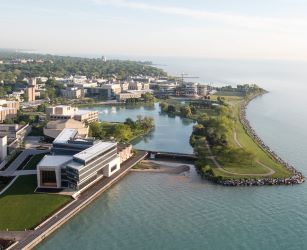Buildings & Infrastructure
The University owns and operates over 220 buildings, totalling more than 16 million square feet, in the City of Evanston and the City of Chicago. Northwestern’s buildings and facilities, which accommodate the activities of thousands of students, researchers, faculty, staff, and visitors each year, account for approximately 99 percent of the University’s Scope 1 and 2 carbon footprint. [1] Northwestern’s emissions from buildings and facilities are comprised of two primary sources: campus electricity consumption and natural gas combustion to operate, heat, and cool buildings. Emissions from both sources must be reduced to support Northwestern’s carbon and energy reduction goals. Beyond emissions, the built environment plays a significant role in health, wellbeing, and campus resiliency.
Northwestern’s past energy efficiency efforts allowed the University to reduce energy consumption by 25% from a 2010 baseline, exceeding its 20% reduction target. The Buildings and Infrastructure Program Area will build on this success, focusing on construction and campus operations as well as improving efficiency and resiliency. Further, it will provide direction to ensure campus spaces are healthy, safe, reliable, and accessible to all members of the Northwestern community. Activities in this Program Area will guide decisions for new construction, renovations, operations, and maintenance practices, as well as ongoing building performance data tracking.
Goals
- Northwestern’s goal is to ensure existing facilities, new construction, and supporting campus infrastructure are resilient, reliable, accessible, and sustainable.
Actions in Progress
Enhance design and construction guidelines for new facilities and major retrofits, integrating current best practices as well as consideration of embodied [2] carbon of materials.
Energy Efficiency and Clean Tech Partnership

What You Can Do
Get Involved
Rally your friends and colleagues, and help us make sustainable living a part of our campus culture. Visit the Take Action page to learn about ways to get started.
Take Action[1] Scope 1 emissions primarily include direct emissions form on-campus fossil fuel combustion – e.g., natural gas, diesel, and gasoline; Scope 2 emissions are associated with Northwestern’s use of electricity.
[2] Embodied carbon is defined as the greenhouse gas emissions that occur from the manufacturing, transportation, installation, maintenance, and disposal of building materials